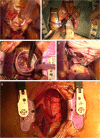Minimally invasive approach: is this the future of aortic surgery?
- PMID: 35463712
- PMCID: PMC8980970
- DOI: 10.1007/s12055-021-01258-2
Minimally invasive approach: is this the future of aortic surgery?
Abstract
Median sternotomy incision has shown to be a safe and efficacious approach in patients who require thoracic aortic interventions and still represents the gold-standard access. Nevertheless, over the last decade, less invasive techniques have gained wider clinical application in cardiac surgery becoming the first-choice approach to treat heart valve diseases, in experienced centers. The popularization of less invasive techniques coupled with an increased patient demand for less invasive therapies has motivated aortic surgeons to apply minimally invasive approaches to more challenging procedures, such as aortic root replacement and arch repair. However, technical demands and the paucity of available clinical data have still limited the widespread adoption of minimally invasive thoracic aortic interventions. This review aimed to assess and comment on the surgical techniques and the current evidence on mini thoracic aortic surgery.
Supplementary information: The online version contains supplementary material available at 10.1007/s12055-021-01258-2.
Keywords: Mini-Bentall operation; Mini-David operation; Minimally invasive cardiac surgery; Thoracic aortic surgery.
© The Author(s) 2021.
Conflict of interest statement
Conflict of interestThe authors declare no competing interests.
Figures




References
LinkOut - more resources
Full Text Sources
